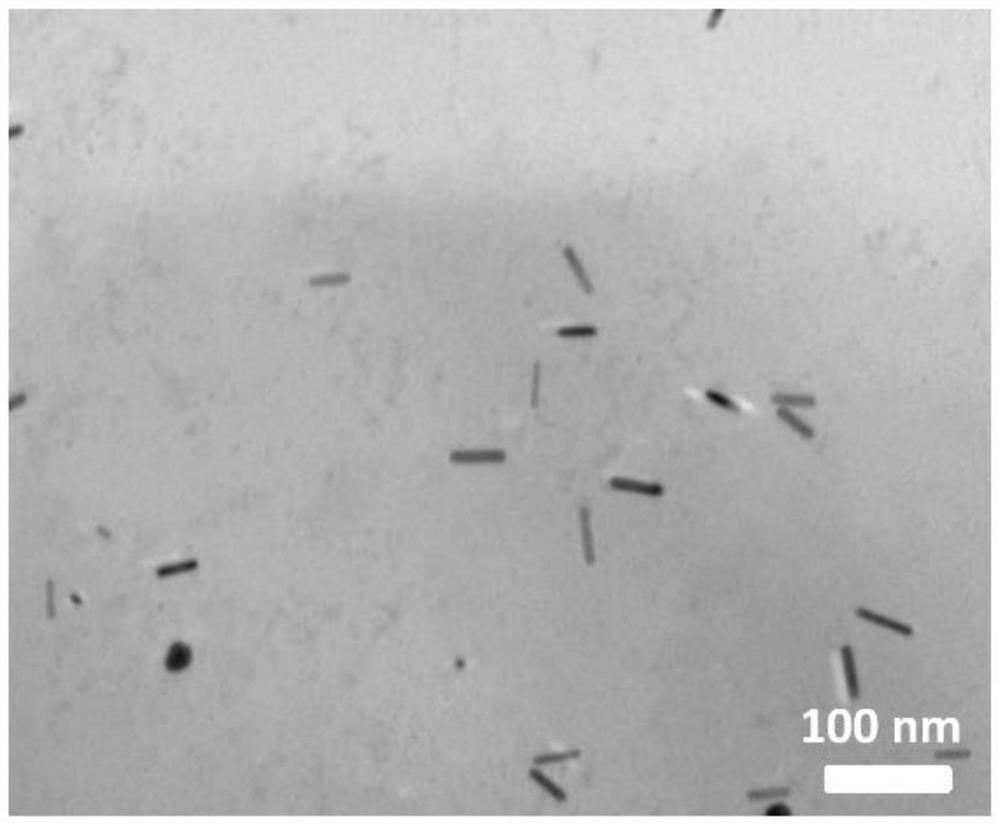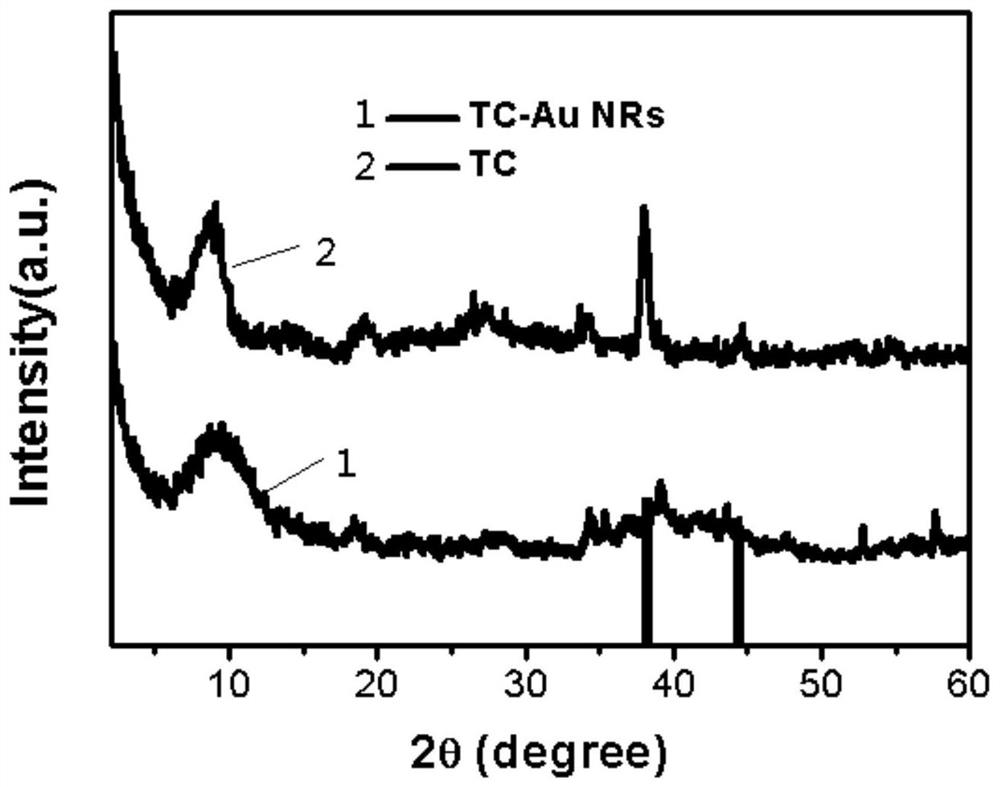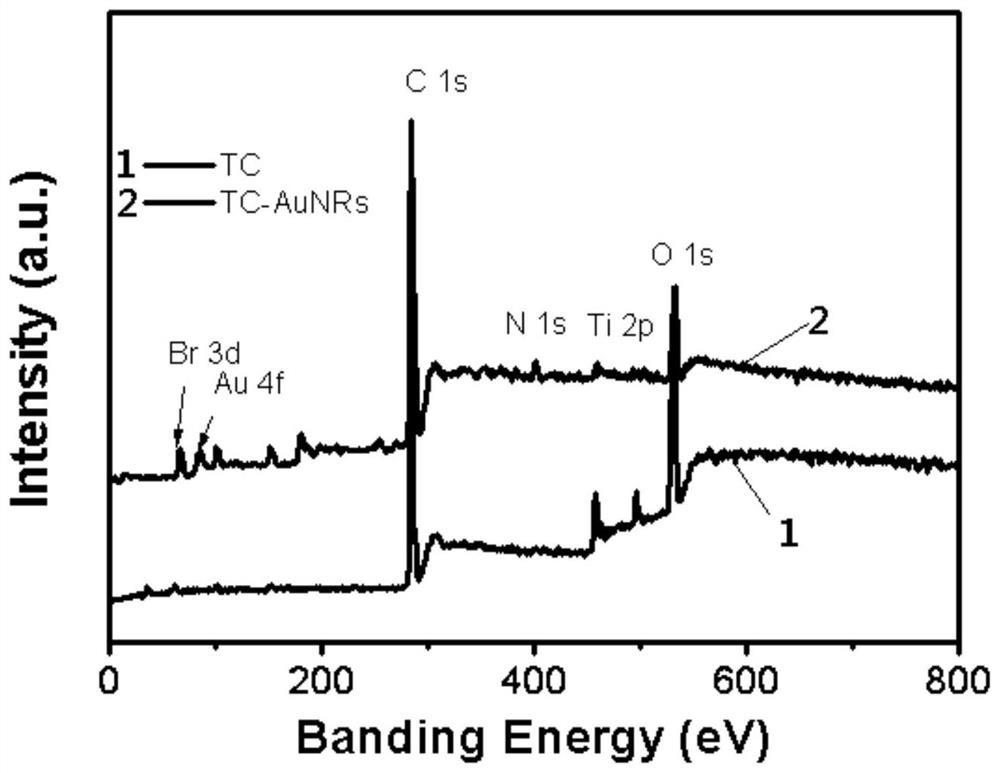Composite material for photoelectrochemical water decomposition, preparation method and application thereof, and electrode
A technology of photoelectrochemistry and composite materials, which is applied in the field of composite materials and its preparation, can solve the problems of limiting the quantum efficiency of highly active catalysts and low total light absorption intensity, and achieve good photoelectric conversion efficiency, good hydrogen production rate, and extended absorption spectrum Effect
- Summary
- Abstract
- Description
- Claims
- Application Information
AI Technical Summary
Problems solved by technology
Method used
Image
Examples
Embodiment 1
[0032] This embodiment provides a composite material for photoelectrochemical water splitting, and its preparation method comprises the following steps:
[0033] S1, cetyltrimethylammonium bromide (CTAB), HAuCl 4 and Ti 3 C 2 -MXene nanosheets formulated into a solution and added NaBH 4 Mix and stir at a temperature of 30°C for 2 hours to obtain a seed solution for later use; wherein, in the seed solution, the concentration of hexadecyltrimethylammonium bromide is 0.1mol / L, HAuCl 4 The concentration is 1mmol / L, Ti 3 C 2 -The concentration of MXene nanosheets is 1mg / mL, NaBH 4 The concentration is 10mmol / L.
[0034] S2, cetyltrimethylammonium bromide and HAuCl 4 formulated as a solution and added AgNO 3 After mixing with HCl, add ascorbic acid for mixing to obtain a mixed solution; wherein, in the mixed solution, AgNO 3 The concentration of HCl is 10mmol / L, the concentration of HCl is 2mol / L, the concentration of ascorbic acid is 0.1mol / L, the concentration of cetyltri...
Embodiment 2
[0038] This embodiment provides a composite material for photoelectrochemical water splitting, and its preparation method comprises the following steps:
[0039] S1, cetyltrimethylammonium bromide (CTAB), HAuCl 4 and Ti 3 C 2 -MXene nanosheets formulated into a solution and added NaBH 4 Mix and stir for 2 hours at a temperature of 25°C to obtain a seed solution for later use; wherein, in the seed solution, the concentration of hexadecyltrimethylammonium bromide is 0.05mol / L, HAuCl 4 The concentration is 0.5mmol / L, Ti 3 C 2 -The concentration of MXene nanosheets is 0.5 mg / mL, NaBH 4 The concentration is 5mmol / L.
[0040] S2, cetyltrimethylammonium bromide and HAuCl 4 formulated as a solution and added AgNO 3 After mixing with HCl, add ascorbic acid for mixing to obtain a mixed solution; wherein, in the mixed solution, AgNO 3 The concentration of HCl is 5mmol / L, the concentration of HCl is 1mol / L, the concentration of ascorbic acid is 0.05mol / L, the concentration of cet...
Embodiment 3
[0044] This embodiment provides a composite material for photoelectrochemical water splitting, and its preparation method comprises the following steps:
[0045] S1, cetyltrimethylammonium bromide (CTAB), HAuCl 4 and Ti 3 C 2 -MXene nanosheets formulated into a solution and added NaBH 4 Mix and stir at a temperature of 35°C for 2 hours to obtain a seed solution for later use; wherein, in the seed solution, the concentration of cetyltrimethylammonium bromide is 0.15mol / L, HAuCl 4 The concentration is 1.5mmol / L, Ti 3 C 2 -The concentration of MXene nanosheets is 1.5mg / mL, NaBH 4 The concentration is 15mmol / L.
[0046] S2, cetyltrimethylammonium bromide and HAuCl 4 formulated as a solution and added AgNO 3 After mixing with HCl, add ascorbic acid for mixing to obtain a mixed solution; wherein, in the mixed solution, AgNO 3 The concentration of HCl is 15mmol / L, the concentration of HCl is 3mol / L, the concentration of ascorbic acid is 0.15mol / L, the concentration of hexade...
PUM
 Login to View More
Login to View More Abstract
Description
Claims
Application Information
 Login to View More
Login to View More - R&D
- Intellectual Property
- Life Sciences
- Materials
- Tech Scout
- Unparalleled Data Quality
- Higher Quality Content
- 60% Fewer Hallucinations
Browse by: Latest US Patents, China's latest patents, Technical Efficacy Thesaurus, Application Domain, Technology Topic, Popular Technical Reports.
© 2025 PatSnap. All rights reserved.Legal|Privacy policy|Modern Slavery Act Transparency Statement|Sitemap|About US| Contact US: help@patsnap.com



